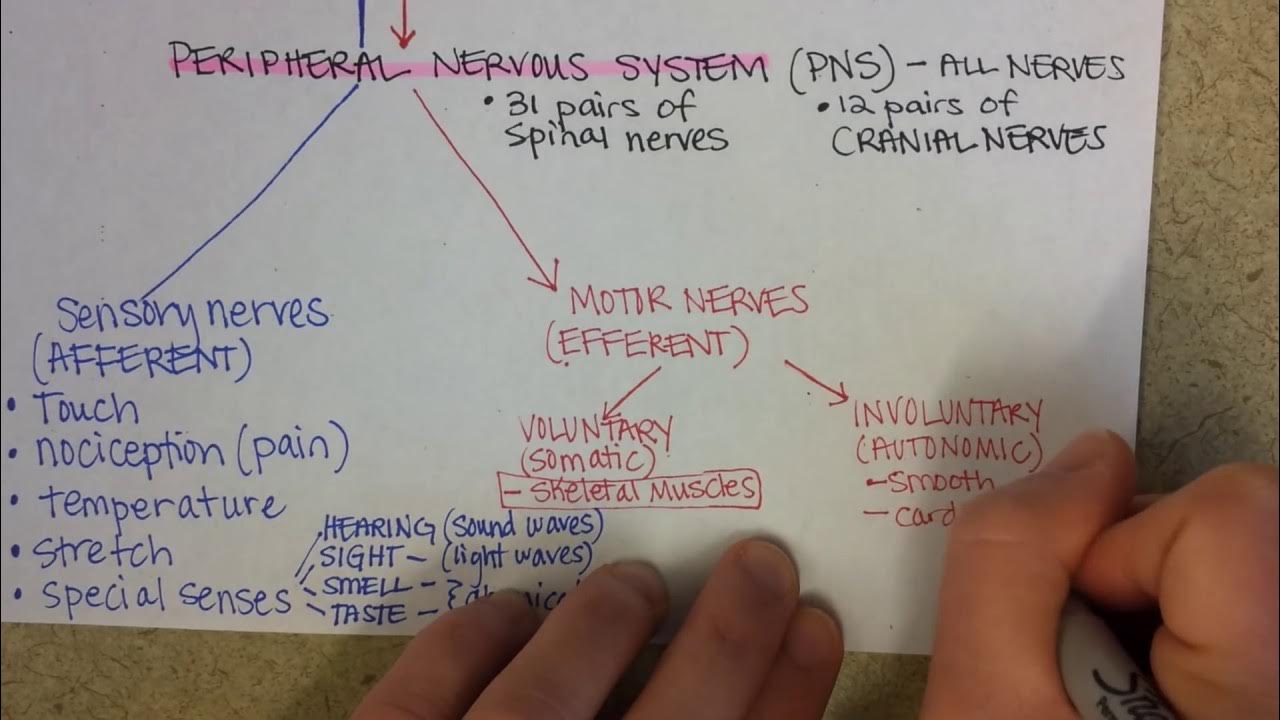Neurology | Descending Tracts: Vestibulospinal Tract
Summary
TLDRThis educational video script delves into the vestibular spinal tract, a crucial component of the nervous system responsible for activating extensor or anti-gravity muscles. It emphasizes the tract's role in maintaining posture and balance during linear and angular acceleration. The script explains the tract's origin in the vestibular nuclear complex, its stimulation from the inner ear and cerebellum, and its pathway to motor neurons. It also highlights the red nucleus's inhibitory function to prevent extensor hypertonus, ensuring a balanced muscle response.
Takeaways
- 🌟 The video series will cover four descending tracks in the nervous system, focusing on the vestibular spinal tract in the first video.
- 🔍 The vestibular spinal tract is primarily responsible for activating extensor muscles, which are crucial for posture and balance.
- 💪 The tract is particularly important for anti-gravity muscles, which help maintain posture and balance during linear and angular acceleration.
- 🏠 The vestibular nuclear complex, located in the upper part of the medulla, is the main structure that receives stimuli for the vestibular spinal tract.
- 🌀 Stimuli to the vestibular nuclear complex come from the inner ear structures, such as the macula and the cristae of the semicircular ducts, and from the cerebellum's vestibular and fastigial nuclei.
- 📢 The lateral and medial vestibular nuclei are the main components of the vestibular spinal tract, with the lateral controlling limb and trunk extension, and the medial controlling head and neck musculature.
- 🚀 The vestibular spinal tract sends fibers down to the spinal cord, where they synapse with alpha and gamma motor neurons to control muscle contractions.
- 👁 The tract also has a role in controlling eye movement through connections with the oculomotor system, although this is not the main focus of the script.
- 🚑 The red nucleus in the midbrain acts as an inhibitory control for the vestibular spinal tract, preventing excessive contraction of extensor muscles.
- 🛑 Without the inhibitory control from the red nucleus, there could be a risk of extensor hypertonus, where the extensor muscles contract excessively.
- 📚 The script emphasizes the importance of understanding the function and control of the vestibular spinal tract for maintaining balance and posture during movement.
Q & A
What is the main function of the vestibulospinal tract?
-The main function of the vestibulospinal tract is to activate extensor muscles, specifically anti-gravity muscles that help maintain posture and balance.
What are the primary components of the vestibulospinal tract?
-The primary components of the vestibulospinal tract are the lateral vestibular nucleus and the medial vestibular nucleus.
Where is the vestibular nuclear complex located?
-The vestibular nuclear complex is located within the upper part of the medulla.
What stimuli do the vestibular nuclei receive?
-The vestibular nuclei receive stimuli from the macula in the utricle and saccule (which detect linear acceleration) and from the crista ampullaris in the semicircular ducts (which detect angular acceleration). Additionally, they receive proprioceptive information from the cerebellum.
What role does the cerebellum play in the vestibulospinal tract?
-The cerebellum provides proprioceptive information to the vestibular nuclear complex, helping it understand the position of muscles, tendons, joints, and ligaments, which is crucial for coordinating muscle contractions accurately.
What is the difference between the medial and lateral vestibulospinal tracts?
-The medial vestibulospinal tract primarily controls head and neck musculature, while the lateral vestibulospinal tract controls limb and trunk extensor muscles, which are important for maintaining posture and balance.
How does the vestibulospinal tract interact with motor neurons?
-The vestibulospinal tract sends descending fibers to the spinal cord, where they stimulate alpha and gamma motor neurons in the anterior or ventral gray horn. These motor neurons then innervate extensor muscles to maintain posture and balance.
What is the role of the red nucleus in the vestibulospinal tract system?
-The red nucleus provides inhibitory signals to the vestibular nuclear complex, preventing excessive contraction of extensor muscles and ensuring proper muscle tone.
What happens if the inhibitory signals from the red nucleus are absent?
-If inhibitory signals from the red nucleus are absent, it could lead to extensor hypertonus, where extensor muscles contract excessively.
What additional function does the vestibular nuclear complex have besides controlling extensor muscles?
-The vestibular nuclear complex can also send fibers to control eye movements via the medial longitudinal fasciculus, influencing the third, fourth, and sixth cranial nerves.
Outlines

Этот раздел доступен только подписчикам платных тарифов. Пожалуйста, перейдите на платный тариф для доступа.
Перейти на платный тарифMindmap

Этот раздел доступен только подписчикам платных тарифов. Пожалуйста, перейдите на платный тариф для доступа.
Перейти на платный тарифKeywords

Этот раздел доступен только подписчикам платных тарифов. Пожалуйста, перейдите на платный тариф для доступа.
Перейти на платный тарифHighlights

Этот раздел доступен только подписчикам платных тарифов. Пожалуйста, перейдите на платный тариф для доступа.
Перейти на платный тарифTranscripts

Этот раздел доступен только подписчикам платных тарифов. Пожалуйста, перейдите на платный тариф для доступа.
Перейти на платный тариф5.0 / 5 (0 votes)






